
Birds are fascinating creatures. Their colorful plumage and attractive songs brighten the place up. Their ability to fly has fascinated humans at least since Icarus. Some species are among the most intelligent vertebrates on earth (a film associated with that article is quite entertaining). And, arguably most excitingly, they evolved from dinosaurs, but the evolutionary relationship between extant species has been a matter of some debate.
To address this question, the Avian Genome sequencing consortium got together to sequence the genomes of 45 species of birds representing 36 orders and used this information to construct a phylogeny of the order Aves. The articles describing this sequencing effort and the resulting analyses were published in a variety of journals in December. The two main articles were published in Science.

BioMed Central journals have been involved in publishing these studies. The genomes of two species of penguin were published in GigaScience, providing insights into how these birds have adapted to their extreme environment. The genome of the crested ibis has been published in Genome Biology. This species nearly became extinct, and the current population is descended from just seven individuals. Such an extreme bottleneck has resulted in a characteristic genetic signature. Genome Biology has also published articles describing a collection of genes that are missing from the genomes of birds, despite being conserved in other vertebrates, which raises questions as to how birds are managing without these genes; and finding that bird genomes are surprisingly depleted in retroviruses.
In BMC Genomics is an article which recreates the inferred chromosomal structure of the avian ancestor. It concludes that the chicken genome most resembles the putative ancestor, which means that chickens are the closest living thing to velociraptors; that’s something worth thinking about next time you visit Nando’s. The same journal also has a study of features of genomes unique to songbirds, which helps provide some insights into what it is that allows these birds to learn and produce such complex vocalizations (and, in many cases, to mimic other sounds).

As well as specific insights into various characteristics of birds, the wealth of data produced by the consortium has allowed insights to be gained into various general principles of evolution, particularly when compared with similar data from other vertebrate lineages such as mammals. These include studies of how sex chromosomes evolve ( in BMC Evolutionary Biology) and how there are problems with using the Kr/Kc measure of nucleotide changes to infer selection pressure on genes (in Genome Biology).
These genomes have allowed the publication of 24 articles, but it is clear that this is a huge dataset that has yet to be fully explored. The publication of Avianbase will help researchers exploit the genomic data that have been generated, and when new bird genomes are sequenced, the ready availability of these 45 genomes will be a great help for analysis of the new genomes
Andrew Cosgrove
Latest posts by Andrew Cosgrove (see all)
- Exploring the history of smallpox vaccination with 19th Century American vaccination kits - 16th November 2020
- The fascination of plant genomes - 20th May 2019
- Genome Biology at Genome Informatics - 18th February 2019
Comments